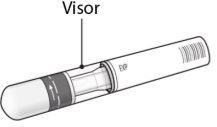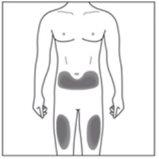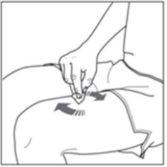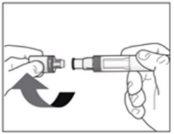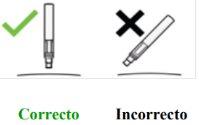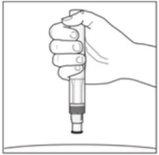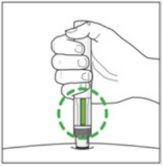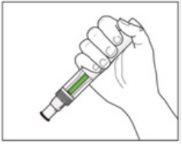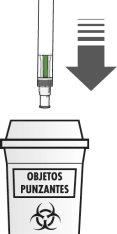
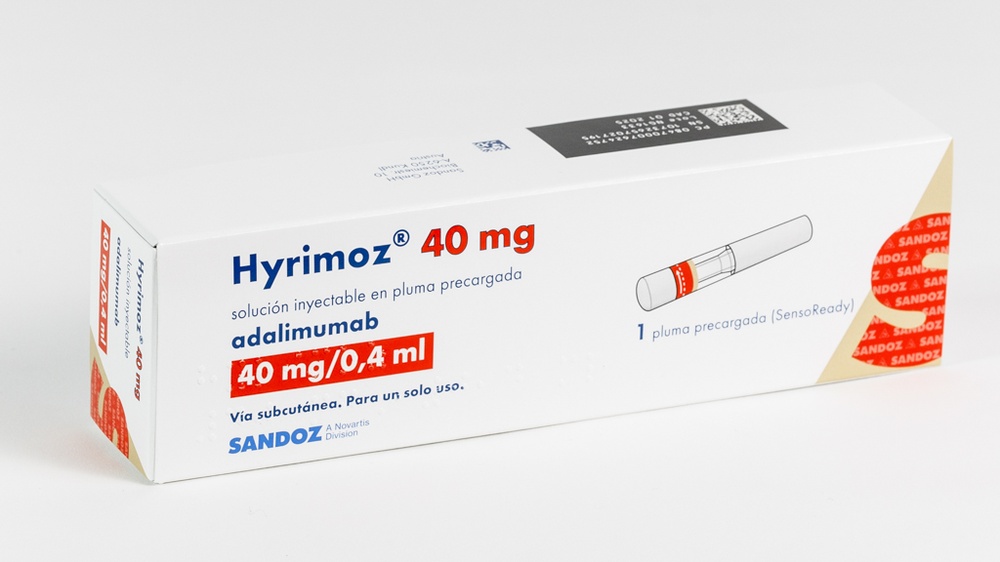
ХИРИМОЗ 40 мг РАСТВОР ДЛЯ ИНЪЕКЦИЙ В ПРЕДНАПОЛНЕННОМ ШПРИЦЕ-РУЧКЕ


Инструкция по применению ХИРИМОЗ 40 мг РАСТВОР ДЛЯ ИНЪЕКЦИЙ В ПРЕДНАПОЛНЕННОМ ШПРИЦЕ-РУЧКЕ
Введение
Проспект: информация для пациента
Hyrimoz 40 мг раствор для инъекций в предварительно заполненном шприце
адалимумаб
40 мг/0,4 мл
Прочитайте внимательно весь проспект перед началом использования этого лекарства, поскольку он содержит важную информацию для вас.
- Сохраните этот проспект, поскольку вам может потребоваться прочитать его снова.
- Ваш врач даст вам карту информации для пациента, содержащую важную информацию о безопасности, которую вам необходимо знать до и во время лечения Hyrimoz.
Сохраните эту карту информации для пациентаво время лечения и в течение 4 месяцев после последней инъекции (или инъекции вашего ребенка) Hyrimoz.
- Если у вас есть какие-либо вопросы, проконсультируйтесь с вашим врачом или фармацевтом.
- Это лекарство было назначено только вам, и его не следует давать другим людям, даже если они имеют те же симптомы, что и вы, поскольку оно может нанести им вред.
- Если вы испытываете побочные эффекты, проконсультируйтесь с вашим врачом или фармацевтом, даже если это побочные эффекты, которые не указаны в этом проспекте. См. раздел 4.
Содержание проспекта
- Что такое Hyrimoz и для чего он используется
- Что вам нужно знать перед началом использования Hyrimoz
- Как использовать Hyrimoz
- Возможные побочные эффекты
- Хранение Hyrimoz
- Содержание упаковки и дополнительная информация
- Инструкции по применению
1. Что такое Hyrimoz и для чего он используется
Hyrimoz содержит активное вещество адалимумаб, лекарство, которое действует на иммунную систему (систему защиты) вашего организма.
Hyrimoz показан для лечения воспалительных заболеваний, описанных ниже:
- ревматоидный артрит,
- ювенильный идиопатический полиартрит,
- артрит, ассоциированный с энтезитом,
- анкилозирующий спондилит
- аксиальный спондилоартрит без радиографических признаков анкилозирующего спондилита,
- псориатический артрит,
- псориаз в виде бляшек,
- гидраденит суппуративус,
- болезнь Крона,
- язвенный колит,
- неинфекционный увеит.
Активное вещество Hyrimoz, адалимумаб, является моноклональным антителом. Моноклональные антитела - это белки, которые атакуют конкретную мишень в организме.
Мишенью адалимумаба является другая белок, называемая фактором некроза опухоли (TNFα), который находится в высоких концентрациях при вышеуказанных воспалительных заболеваниях. Блокируя действие TNFα, Hyrimoz уменьшает воспаление при этих заболеваниях.
Ревматоидный артрит
Ревматоидный артрит - это воспалительное заболевание суставов.
Hyrimoz используется для лечения ревматоидного артрита у взрослых. Если вы страдаете активным ревматоидным артритом средней или тяжелой степени, вам могут назначить другие лекарства, модифицирующие заболевание, такие как метотрексат. Если эти лекарства не работают достаточно хорошо, вам будет назначен Hyrimoz для лечения ревматоидного артрита.
Hyrimoz также может быть использован для лечения тяжелого, активного и прогрессирующего ревматоидного артрита без предыдущего лечения метотрексатом.
Hyrimoz может уменьшить повреждение суставов и костей, вызванное заболеванием, и улучшить физическую активность.
Обычно Hyrimoz используется вместе с метотрексатом. Если ваш врач считает, что метотрексат не подходит, Hyrimoz может быть назначен в одиночку.
Ювенильный идиопатический полиартрит
Ювенильный идиопатический полиартрит - это воспалительное заболевание суставов, которое обычно появляется в детстве.
Hyrimoz используется для лечения ювенильного идиопатического полиартрита у детей и подростков в возрасте от 2 до 17 лет. Пациенты могут получить другие лекарства, модифицирующие заболевание, такие как метотрексат. Если эти лекарства не работают достаточно хорошо, пациентам будет назначен Hyrimoz.
Артрит, ассоциированный с энтезитом
Артрит, ассоциированный с энтезитом, - это воспалительное заболевание суставов и мест прикрепления сухожилий к кости. Hyrimoz используется для лечения артрита, ассоциированного с энтезитом, у пациентов старше 6 лет. Пациенты могут получить другие лекарства, модифицирующие заболевание, такие как метотрексат. Если они не реагируют достаточно хорошо на эти лекарства, им будет назначен Hyrimoz.
Анкилозирующий спондилит и аksiальный спондилоартрит без радиографических признаков анкилозирующего спондилита
Анкилозирующий спондилит и аksiальный спондилоартрит без радиографических признаков анкилозирующего спондилита - это воспалительные заболевания, поражающие позвоночник.
Hyrimoz используется у взрослых для лечения этих заболеваний. Если у вас анкилозирующий спондилит или аksiальный спондилоартрит без радиографических признаков анкилозирующего спондилита, вам будут назначены другие лекарства, и если они не работают достаточно хорошо, вам будет назначен Hyrimoz для уменьшения симптомов и признаков заболевания.
Псориаз в виде бляшек у взрослых и детей
Псориаз в виде бляшек - это воспалительное заболевание кожи, которое вызывает красные, чешуйчатые, с корками и покрытые серебристыми чешуйками области. Псориаз в виде бляшек также может поражать ногти, вызывая их разрушение, утолщение и отслоение от ногтевого ложа, что может быть болезненным. Предполагается, что псориаз вызван дефектом иммунной системы организма, который приводит к увеличению производства клеток кожи.
Hyrimoz используется для лечения псориаза в виде бляшек средней или тяжелой степени у взрослых. Hyrimoz также используется для лечения псориаза в виде бляшек тяжелой степени у детей и подростков в возрасте от 4 до 17 лет, которые не реагируют или не являются хорошими кандидатами для лечения местными лекарствами или терапией ультрафиолетовым светом.
Псориатический артрит
Псориатический артрит - это воспалительное заболевание суставов, ассоциированное с псориазом.
Hyrimoz используется для лечения псориатического артрита у взрослых. Hyrimoz может уменьшить повреждение суставов, вызванное заболеванием, и улучшить физическую активность.
Гидраденит суппуративус у взрослых и подростков
Гидраденит суппуративус (иногда называемый обратным акне) - это долгосрочное и часто болезненное воспалительное заболевание кожи. Симптомы могут включать чувствительные узлы (бугорки) и абсцессы (фурункулы), которые могут выделять гной.
Обычно он поражает определенные области кожи, такие как под грудью, в подмышках, внутренней части бедер, паху и ягодицах. Также могут быть рубцы в пораженных областях.
Hyrimoz используется для лечения
- гидраденита суппуративуса средней или тяжелой степени у взрослых и
- гидраденита суппуративуса средней или тяжелой степени у подростков в возрасте от 12 до 17 лет.
Hyrimoz может уменьшить количество узлов и абсцессов, а также боль, обычно ассоциированную с этим заболеванием. Вам могут быть назначены другие лекарства ранее. Если эти лекарства не работают достаточно хорошо, вам будет назначен Hyrimoz.
Болезнь Крона у взрослых и детей
Болезнь Крона - это воспалительное заболевание пищеварительного тракта.
Hyrimoz используется для лечения
- болезни Крона средней или тяжелой степени у взрослых и
- болезни Крона средней или тяжелой степени у детей и подростков в возрасте от 6 до 17 лет.
Если вы страдаете болезнью Крона, вам будут назначены другие лекарства, и если они не работают достаточно хорошо, вам будет назначен Hyrimoz для уменьшения симптомов и признаков болезни Крона.
Язвенный колит у взрослых и детей
Язвенный колит - это воспалительное заболевание толстой кишки.
Hyrimoz используется для лечения
- язвенного колита средней или тяжелой степени у взрослых и
- язвенного колита средней или тяжелой степени у детей и подростков в возрасте от 6 до 17 лет.
Если вы страдаете язвенным колитом, вам могут быть назначены другие лекарства, и если они не работают достаточно хорошо, вам будет назначен Hyrimoz для уменьшения симптомов и признаков язвенного колита.
Неинфекционный увеит у взрослых и детей
Неинфекционный увеит - это воспалительное заболевание, поражающее определенные части глаза. Воспаление приводит к уменьшению зрения и/или появлению мух в глазу (черных точек или тонких линий, движущихся вдоль поля зрения). Hyrimoz действует, уменьшая это воспаление.
Hyrimoz используется для лечения
- взрослых с неинфекционным увеитом с воспалением, поражающим заднюю часть глаза,
- детей старше 2 лет с хроническим неинфекционным увеитом с воспалением, поражающим переднюю часть глаза.
Вам могут быть назначены другие лекарства ранее. Если вы не реагируете достаточно хорошо на эти лекарства, вам будет назначен Hyrimoz.
2. Что необходимо знать до начала использования Hyrimoz вашим ребенком
Не используйте Hyrimoz
- Если у вас аллергия на адалимумаб или на любой другой компонент этого лекарственного средства (перечисленные в разделе 6).
- Если у вас тяжелая инфекция, включая туберкулез, сепсис (отравление крови) или другие оппортунистические инфекции (редкие инфекции, связанные с ослаблением иммунной системы). В случае появления симптомов любой инфекции, например: лихорадки, ран, усталости, проблем с зубами, важно сообщить об этом вашему врачу (см. «Предостережения и меры предосторожности»).
- Если у вас умеренная или тяжелая сердечная недостаточность. Важно сообщить вашему врачу, если у вас были или есть серьезные проблемы с сердцем (см. «Предостережения и меры предосторожности»).
Предостережения и меры предосторожности
Проконсультируйтесь с вашим врачом или фармацевтом перед началом использования Hyrimoz.
Аллергическая реакция
- Если у вас аллергическая реакция с симптомами, такими как сдавление в груди, затруднение дыхания, головокружение, отек или сыпь, прекратите введение Hyrimoz и немедленно свяжитесь с вашим врачом, поскольку в редких случаях эти реакции могут представлять угрозу для жизни.
Инфекции
- Если у вас есть любая инфекция, включая хронические или локализованные (например, язва на ноге), проконсультируйтесь с вашим врачом перед началом лечения Hyrimoz. Если вы не уверены, свяжитесь с вашим врачом.
- При лечении Hyrimoz вы можете с большей легкостью заразиться инфекциями. Этот риск может быть выше, если снижается активность ваших легких. Эти инфекции могут быть тяжелыми и включать туберкулез, вирусные, грибковые, паразитарные или бактериальные инфекции, а также сепсис (отравление крови).
- В редких случаях эти инфекции могут представлять угрозу для вашей жизни. Важно сообщить вашему врачу, если у вас появляются симптомы, такие как лихорадка, раны, усталость или проблемы с зубами. Ваш врач может рекомендовать временно прекратить лечение Hyrimoz.
Туберкулез (ТБ)
- Поскольку были описаны случаи туберкулеза у пациентов, получавших лечение адалимумабом, ваш врач осмотрит вас на предмет признаков или симптомов туберкулеза перед началом вашего лечения Hyrimoz. Это будет включать проведение тщательного медицинского обследования, включая вашу медицинскую историю и диагностические тесты (например, рентгенографию легких и пробу Манту). Результаты этих тестов должны быть записаны в вашей карте информации для пациента. Очень важно сообщить вашему врачу, если вы страдали туберкулезом или были в контакте с пациентом, больным туберкулезом. Туберкулез может развиться во время лечения, даже если вы получали профилактическое лечение против туберкулеза. Если появляются симптомы туберкулеза (постоянный кашель, потеря веса, отсутствие энергии, субфебрилитет) или любой другой инфекции во время или после лечения, немедленно свяжитесь с вашим врачом.
Путешествия/рецидивирующая инфекция
- Сообщите вашему врачу, если вы проживали или путешествовали в регионах, где часто встречаются грибковые инфекции, такие как гистоплазмоз, кокцидиоидомикоз или бластомикоз.
- Сообщите вашему врачу, если у вас есть история рецидивирующих инфекций или других заболеваний или факторов, которые увеличивают риск инфекций.
Вирус гепатита Б
- Сообщите вашему врачу, если вы являетесь носителем вируса гепатита Б (ВГБ), если у вас активная инфекция ВГБ или если вы считаете, что можете быть подвержены риску заражения ВГБ. Ваш врач должен провести анализ на ВГБ. Адалимумаб может реактивировать ВГБ у носителей этого вируса. В редких случаях, особенно если вы принимаете другие лекарства, которые подавляют иммунную систему, реактивация ВГБ может представлять угрозу для вашей жизни.
Возраст старше 65 лет
- Если вам больше 65 лет, вы можете быть более восприимчивы к инфекциям во время лечения Hyrimoz. И вы, и ваш врач должны обратить особое внимание на появление признаков инфекции во время лечения Hyrimoz. Важно сообщить вашему врачу, если у вас появляются симптомы инфекций, такие как лихорадка, раны, чувство усталости или проблемы с зубами.
Стоматологические процедуры или хирургия
- Если вам предстоит хирургическая или стоматологическая операция, сообщите вашему врачу, что вы используете Hyrimoz. Ваш врач может рекомендовать временно прекратить лечение Hyrimoz.
Демиелинизирующие заболевания
- Если у вас есть или развивается демиелинизирующее заболевание (заболевание, поражающее изолирующую оболочку, окружающую нервы, такое как рассеянный склероз), ваш врач решит, следует ли вам быть леченным или продолжать лечение Hyrimoz. Немедленно сообщите вашему врачу, если у вас появляются симптомы, такие как изменения в зрении, слабость в руках или ногах или онемение или покалывание в любой части тела.
Вакцины
- Некоторые вакцины содержат живые, но ослабленные формы бактерий или вирусов, которые вызывают заболевания, и не должны вводиться во время лечения Hyrimoz, поскольку они могут вызвать инфекции. Проконсультируйтесь с вашим врачом перед введением любой вакцины. Рекомендуется, если это возможно, чтобы дети получили все запланированные для их возраста вакцины до начала лечения Hyrimoz. Если вы получаете Hyrimoz во время беременности, ваш ребенок может иметь более высокий риск заразиться инфекциями в течение примерно 5 месяцев после последней дозы Hyrimoz, которую вы получили во время беременности. Важно сообщить педиатру и другим медицинским работникам о вашем использовании Hyrimoz во время беременности, чтобы они могли решить, следует ли вашему ребенку получать какие-либо вакцины.
Сердечная недостаточность
- Важно сообщить вашему врачу, если у вас были или есть серьезные проблемы с сердцем. Если у вас легкая сердечная недостаточность и вы получаете лечение Hyrimoz, ваш врач должен постоянно наблюдать за вашей сердечной недостаточностью. В случае появления новых симптомов сердечной недостаточности или ухудшения существующих (например, затруднения дыхания или отека ног), вы должны немедленно связаться с вашим врачом.
Лихорадка, синяки, кровотечение или бледный вид
- У некоторых пациентов организм может быть неспособен производить достаточное количество определенного типа клеток крови, которые борются с инфекциями (белые кровяные клетки) или которые способствуют остановке кровотечений (тромбоциты). Если у вас постоянная лихорадка, синяки или вы легко кровоточите или очень бледны, немедленно проконсультируйтесь с вашим врачом. Ваш врач может решить прекратить лечение.
Рак
- В очень редких случаях были зарегистрированы случаи определенных типов рака у детей и взрослых, леченных адалимумабом или другими агентами, блокирующими TNFα. Люди с ревматоидным артритом более тяжелых степеней и длительным течением могут иметь более высокий риск развития лимфомы и лейкемии (рака, поражающего клетки крови и костный мозг). Если вы получаете лечение Hyrimoz, риск развития лимфомы, лейкемии и других типов рака может увеличиться. Были зарегистрированы редкие случаи определенного типа лимфомы у пациентов, получавших лечение адалимумабом.
Некоторые из этих пациентов также получали лечение азатиоприном или меркаптопурином. Сообщите вашему врачу, если вы принимаете азатиоприн или меркаптопурин с Hyrimoz.
- Кроме того, были зарегистрированы случаи рака кожи (немонеланома) у пациентов, использующих адалимумаб. Сообщите вашему врачу, если во время или после лечения появляются новые участки поврежденной кожи или если существующие повреждения или участки кожи изменяют свой вид.
- Были зарегистрированы случаи рака, отличного от лимфомы, у пациентов с определенным заболеванием легких, называемым хронической обструктивной болезнью легких (ХОБЛ), леченных другим агентом, блокирующим TNFα. Если у вас ХОБЛ или вы курите много, вам следует проконсультироваться с вашим врачом, чтобы определить, подходит ли лечение блокатором TNFα для вашего случая.
Аутоиммунные заболевания
- В редких случаях лечение Hyrimoz может привести к развитию синдрома, подобного системной красной волчанке. Свяжитесь с вашим врачом, если у вас появляются симптомы, такие как постоянная неясная сыпь, лихорадка, суставная боль или усталость.
Дети и подростки
- Вакцины: если это возможно, ваш ребенок должен быть привит всеми необходимыми вакцинами до начала использования Hyrimoz.
Другие лекарства и Hyrimoz
Сообщите вашему врачу или фармацевту, если вы принимаете, недавно принимали или можете принимать любое другое лекарство.
Hyrimoz можно принимать вместе с метотрексатом или с определенными лекарствами, модифицирующими течение ревматоидного артрита (сульфасалазин, гидроксихлорохин, лефлуномид и инъекционные препараты на основе солей золота), кортикостероидами или обезболивающими препаратами, включая нестероидные противовоспалительные препараты (НПВП).
Не используйте Hyrimoz вместе с лекарствами, активными веществами которых являются анакинра или абатацепт, из-за повышенного риска тяжелой инфекции. Не рекомендуется сочетать адалимумаб и другие антагонисты TNFα с анакинрой или абатацептом из-за возможного увеличения риска инфекций, включая тяжелые, и других возможных фармакологических взаимодействий. Если у вас есть сомнения, проконсультируйтесь с вашим врачом.
Беременность и лактация
- Вам следует рассмотреть возможность использования адекватных методов контрацепции, чтобы избежать беременности и продолжать их использование не менее 5 месяцев после последнего лечения Hyrimoz.
- Если вы беременны, считаете, что можете быть беременной или планируете иметь ребенка, проконсультируйтесь с вашим врачом о использовании этого лекарства.
- Hyrimoz должен использоваться во время беременности только в случае необходимости.
- Согласно исследованию беременности, не было обнаружено повышенного риска врожденных дефектов, когда мать получала лечение адалимумабом во время беременности по сравнению с матерями с тем же заболеванием, не получавшими лечения адалимумабом.
- Hyrimoz можно использовать во время лактации.
- Если вы используете Hyrimoz во время беременности, ваш ребенок может иметь более высокий риск заразиться инфекциями.
- Важно сообщить педиатру и другим медицинским работникам о вашем использовании Hyrimoz во время беременности, чтобы они могли решить, следует ли вашему ребенку получать какие-либо вакцины (для получения более подробной информации о вакцинах см. раздел «Предостережения и меры предосторожности»).
Вождение и использование машин
Влияние Hyrimoz на способность управлять транспортными средствами, ездить на велосипеде или использовать машины незначительно. Может появиться чувство, что комната кружится (вертиго) и нарушения зрения после использования Hyrimoz.
Hyrimoz содержит натрий
Это лекарство содержит менее 1 ммоль (23 мг) натрия на дозу 0,4 мл; это означает, что оно практически «не содержит натрия».
3. Как использовать Хиримоз
Следуйте точно инструкциям по применению этого препарата, указанным вашим врачом. В случае сомнений проконсультируйтесь с вашим врачом снова.
В следующей таблице указаны рекомендуемые дозы Хиримоза для каждого из его одобренных применений. Ваш врач может назначить вам другую дозу Хиримоза, если вам нужна другая доза.
Ревматоидный артрит, псориатический артрит, анкилозирующий спондилит или аксиальный спондилит без радиографических признаков анкилозирующего спондилита | ||
Возраст или вес тела | Какая доза и с какой частотой следует принимать? | Примечания |
Взрослые | 40 мг каждые две недели в качестве единой дозы | В случае ревматоидного артрита лечение метотrexатом продолжается во время использования Хиримоза. Если ваш врач решит, что метотrexат не подходит, Хиримоз можно применять самостоятельно. Если у вас ревматоидный артрит и вы не получаете метотrexат во время лечения Хиримозом, ваш врач может решить давать вам 40 мг Хиримоза каждую неделю или 80 мг каждые две недели. |
Ювенильный идиопатический полиартикулярный артрит | ||
Возраст или вес тела | Какая доза и с какой частотой следует принимать? | Примечания |
Дети, подростки и взрослые с 2 лет и весом 30 кг или более | 40 мг каждые две недели | Не применимо |
Дети и подростки с 2 лет и весом от 10 кг до менее 30 кг | 20 мг каждые две недели | Не применимо |
Артрит, ассоциированный с энтезитом | ||
Возраст или вес тела | Какая доза и с какой частотой следует принимать? | Примечания |
Дети, подростки и взрослые с 6 лет и весом 30 кг или более | 40 мг каждые две недели | Не применимо |
Дети и подростки с 6 лет и весом от 15 кг до менее 30 кг | 20 мг каждые две недели | Не применимо |
Псориаз в виде бляшек | ||
Возраст или вес тела | Какая доза и с какой частотой следует принимать? | Примечания |
Взрослые | Первоначальная доза 80 мг (в виде двух инъекций по 40 мг в один день), за которой следует 40 мг каждые две недели, начиная через одну неделю после первоначальной дозы. | Вы должны продолжать вводить себе Хиримоз в течение того времени, которое указал ваш врач. Если эта доза не работает достаточно хорошо, ваш врач может увеличить дозу до 40 мг в неделю или 80 мг каждые две недели. |
Педиатрический псориаз в виде бляшек | ||
Возраст или вес тела | Какая доза и с какой частотой следует принимать? | Примечания |
Дети и подростки с 4 до 17 лет и весом 30 кг или более | Первоначальная доза 40 мг, за которой следует 40 мг через одну неделю. Затем обычная доза составляет 40 мг каждые две недели. | Не применимо |
Дети и подростки с 4 до 17 лет и весом от 15 кг до менее 30 кг | Первоначальная доза 20 мг, за которой следует 20 мг через одну неделю. Затем обычная доза составляет 20 мг каждые две недели. | Не применимо |
Гидраденит | ||
Возраст или вес тела | Какая доза и с какой частотой следует принимать? | Примечания |
Взрослые | Первоначальная доза 160 мг (в виде четырех инъекций по 40 мг в один день или двух инъекций по 40 мг в день в течение двух последовательных дней), за которой следует доза 80 мг (в виде двух инъекций по 40 мг в один день) через две недели. Затем через две недели более продолжается доза 40 мг в неделю или 80 мг каждые две недели, как назначено вашим врачом. | Рекомендуется использовать ежедневно антисептический раствор в пораженных зонах. |
Подростки с 12 до 17 лет и весом 30 кг или более | Первоначальная доза 80 мг (в виде двух инъекций по 40 мг в один день), за которой следует 40 мг каждые две недели, начиная через одну неделю после первоначальной дозы. | Если эта доза не работает достаточно хорошо, ваш врач может увеличить дозу до 40 мг в неделю или 80 мг каждые две недели. Рекомендуется использовать ежедневно антисептический раствор в пораженных зонах. |
Болезнь Крона | ||
Возраст или вес тела | Какая доза и с какой частотой следует принимать? | Примечания |
Взрослые | Первоначальная доза 80 мг (в виде двух инъекций по 40 мг в один день), за которой следует 40 мг каждые две недели, начиная через две недели после первоначальной дозы. Если требуется более быстрый ответ, ваш врач может назначить первоначальную дозу 160 мг (в виде четырех инъекций по 40 мг в один день или двух инъекций по 40 мг в день в течение двух последовательных дней), за которой следует 80 мг (в виде двух инъекций по 40 мг в один день) через две недели. Затем обычная доза составляет 40 мг каждые две недели. | Если эта доза не работает достаточно хорошо, ваш врач может увеличить дозу до 40 мг в неделю или 80 мг каждые две недели. |
Педиатрическая болезнь Крона | ||
Возраст или вес тела | Какая доза и с какой частотой следует принимать? | Примечания |
Дети и подростки с 6 до 17 лет и весом 40 кг или более | Первоначальная доза 80 мг (в виде двух инъекций по 40 мг в один день), за которой следует 40 мг каждые две недели, начиная через две недели после первоначальной дозы. Если требуется более быстрый ответ, ваш врач может назначить первоначальную дозу 160 мг (в виде четырех инъекций по 40 мг в один день или двух инъекций по 40 мг в день в течение двух последовательных дней), за которой следует 80 мг (в виде двух инъекций по 40 мг в один день) через две недели. Затем обычная доза составляет 40 мг каждые две недели. | Если эта доза не работает достаточно хорошо, врач вашего ребенка может увеличить дозу до 40 мг в неделю или 80 мг каждые две недели. |
Дети и подростки с 6 до 17 лет и весом менее 40 кг | Первоначальная доза 40 мг, за которой следует 20 мг каждые две недели, начиная через две недели после первоначальной дозы. Если требуется более быстрый ответ, ваш врач может назначить первоначальную дозу 80 мг (в виде двух инъекций по 40 мг в один день), за которой следует 40 мг через две недели. Затем обычная доза составляет 20 мг каждые две недели. | Если эта доза не работает достаточно хорошо, врач вашего ребенка может увеличить частоту дозы до 20 мг в неделю. |
Язвенный колит | ||
Возраст или вес тела | Какая доза и с какой частотой следует принимать? | Примечания |
Взрослые | Первоначальная доза 160 мг (в виде четырех инъекций по 40 мг в один день или двух инъекций по 40 мг в день в течение двух последовательных дней), за которой следует 80 мг (в виде двух инъекций по 40 мг в один день) через две недели. Затем обычная доза составляет 40 мг каждые две недели. | Если эта доза не работает достаточно хорошо, ваш врач может увеличить дозу до 40 мг в неделю или 80 мг каждые две недели. |
Педиатрический язвенный колит | ||
Возраст или вес тела | Какая доза и с какой частотой следует принимать? | Примечания |
Дети и подростки с 6 лет и весом 40 кг или более | Первоначальная доза 160 мг (в виде четырех инъекций по 40 мг в один день или двух инъекций по 40 мг в день в течение двух последовательных дней), за которой следует 80 мг (в виде двух инъекций по 40 мг в один день) через две недели. Затем обычная доза составляет 80 мг каждые две недели. | Пациенты, которые достигают 18 лет во время лечения 80 мг каждые две недели, должны продолжать принимать назначенную дозу. |
Дети и подростки с 6 лет и весом менее 40 кг | Первоначальная доза 80 мг (в виде двух инъекций по 40 мг в один день), за которой следует 40 мг (в виде одной инъекции 40 мг) через две недели. Затем обычная доза составляет 40 мг каждые две недели. | Пациенты, которые достигают 18 лет во время лечения 40 мг каждые две недели, должны продолжать принимать назначенную дозу. |
Неинфекционный увеит | ||
Возраст или вес тела | Какая доза и с какой частотой следует принимать? | Примечания |
Взрослые | Первоначальная доза 80 мг (в виде двух инъекций по 40 мг), за которой следует 40 мг каждые две недели, начиная через одну неделю после первоначальной дозы. | При неинфекционном увеите можно продолжать лечение кортикостероидами или другими препаратами, влияющими на иммунную систему, во время использования Хиримоза. Хиримоз также можно применять самостоятельно. Вы должны продолжать вводить себе Хиримоз в течение того времени, которое указал ваш врач. |
Дети и подростки с 2 лет и весом 30 кг или более | 40 мг каждые две недели | Ваш врач также может назначить первоначальную дозу 80 мг, которая может быть введена за одну неделю до начала обычной дозы 40 мг каждые две недели. Рекомендуется использование Хиримоза в комбинации с метотrexатом. |
Дети и подростки с 2 лет и весом менее 30 кг | 20 мг каждые две недели | Ваш врач также может назначить первоначальную дозу 40 мг, которая может быть введена за одну неделю до начала обычной дозы 20 мг каждые две недели. Рекомендуется использование Хиримоза в комбинации с метотrexатом. |
Форма и способ введения
Хиримоз вводится под кожу (подкожно).
Подробные инструкции по введению Хиримоза приведены в разделе 7, «Инструкции по применению».
Если вы примете больше Хиримоза, чем необходимо
Если вы случайно ввели Хиримоз чаще, чем необходимо, позвоните вашему врачу или фармацевту и объясните, что вы приняли больше, чем необходимо. Всегда носите с собой упаковку препарата, даже если она пуста.
Если вы забыли использовать Хиримоз
Если вы забыли ввести себе инъекцию, вы должны ввести следующую дозу Хиримоза как можно скорее. Затем следующая доза будет введена как обычно, как если бы вы не забыли про дозу.
Если вы прекратите лечение Хиримозом
Решение о прекращении использования Хиримоза должно быть обсуждено с вашим врачом. Ваши симптомы могут вернуться после прекращения лечения.
Если у вас есть другие вопросы о использовании этого препарата, проконсультируйтесь с вашим врачом или фармацевтом.
4. Возможные побочные эффекты
Как и все лекарства, это лекарство может вызывать побочные эффекты, хотя не все люди их испытывают. Большинство побочных эффектов легкие или умеренные. Однако некоторые могут быть тяжелыми и требовать лечения. Побочные эффекты могут появляться до 4 месяцев или более после последней инъекции Hyrimoz.
Обратитесь за медицинской помощью немедленно, если заметите любой из следующих признаков аллергической реакции или сердечной недостаточности:
- тяжелая сыпь, крапивница;
- отек лица, рук, ног;
- затруднение дыхания, глотания;
- затруднение дыхания при физической активности или в положении лежа, отек ног.
Свяжитесь со своим врачом как можно скорее, если заметите любой из следующих эффектов
- признаки и симптомы инфекции, такие как лихорадка, тошнота, раны, проблемы с зубами, жжение при мочеиспускании, чувство слабости, усталости или кашля;
- симптомы нервных проблем, таких как онемение, покалывание, двоение в глазах, слабость в руках или ногах;
- признаки рака кожи, такие как выпуклость или открытая рана, которая не заживает;
- признаки и симптомы нарушений крови, такие как постоянная лихорадка, синяки, кровотечения и бледность.
Следующие побочные эффекты были обнаружены при применении адалимумаба:
Очень часто(могут возникать у более 1 из 10 человек)
- реакции в месте инъекции (включая боль, отек, покраснение или зуд);
- инфекции нижних дыхательных путей (включая простуду, насморк, синусит, пневмонию);
- головная боль;
- боль в животе (в животе);
- тошнота и рвота;
- сыпь;
- боль в мышцах.
Часто(могут возникать у до 1 из 10 человек)
- тяжелые инфекции (включая заражение крови и грипп);
- инфекции кишечника (включая гастроэнтерит);
- инфекции кожи (включая целлюлит и герпес);
- инфекция уха;
- инфекции полости рта (включая инфекцию зубов и боль в горле);
- инфекции репродуктивной системы;
- инфекция мочевыводящих путей;
- грибковые инфекции;
- инфекция суставов;
- доброкачественные опухоли;
- рак кожи;
- аллергические реакции (включая сезонную аллергию);
- обезвоживание;
- изменения настроения (включая депрессию);
- тревога;
- сонливость и трудности со сном;
- нарушения чувствительности, такие как онемение, покалывание или жжение;
- мигрень;
- симптомы сдавления нервного корня (включая боль в нижней части спины и ноги);
- нарушения зрения;
- воспаление глаза;
- воспаление век и отек глаза;
- вертиго (чувство, что комната кружится);
- чувство ускоренного пульса;
- высокое кровяное давление;
- краснота;
- гематомы (твердая опухоль с свернувшейся кровью);
- кашель;
- астма;
- затруднение дыхания;
- гastrointestinalное кровотечение;
- диспепсия (изжога, вздутие и жжение);
- кислотный рефлюкс;
- синдром сухого глаза (включая сухость глаз и рта);
- зуд;
- сыпь с зудом;
- синяки;
- воспаление кожи (такое как экзема);
- ломкость ногтей на руках и ногах;
- повышенное потоотделение;
- потеря волос;
- псориаз нового появления или ухудшение существующего псориаза;
- мышечные спазмы;
- кровь в моче;
- проблемы с почками;
- боль в груди;
- отек (накопление жидкости в организме, которое может вызвать отек пораженной ткани);
- лихорадка;
- снижение количества тромбоцитов в крови, что увеличивает риск кровотечения или синяков;
- нарушения заживления.
Не часто(могут возникать у до 1 из 100 человек)
- необычные инфекции (включая туберкулез) и другие инфекции, которые возникают, когда сопротивляемость организма снижается;
- нейроинфекции (включая вирусный менингит);
- инфекции глаза;
- бактериальные инфекции;
- дивертикулит (воспаление и инфекция толстой кишки);
- рак, включая рак, поражающий лимфатическую систему (лимфому) и меланому (тип кожи рака);
- нарушения иммунной системы, которые могут повлиять на легкие, кожу и лимфатические узлы (самое частое проявление - в форме заболевания, называемого саркоидозом);
- васкулит (воспаление кровеносных сосудов);
- дрожь (чувство дрожи);
- нейропатия (повреждение нерва);
- инсульт;
- потеря слуха, звон в ушах;
- чувство нерегулярного пульса, как перебои;
- проблемы с сердцем, которые могут вызвать затруднение дыхания или отек лодыжек;
- инфаркт миокарда;
- грыжа в стенке крупной артерии, воспаление и свертывание в вене, блокирование кровеносного сосуда;
- легочные заболевания, которые могут вызвать затруднение дыхания (включая воспаление);
- легочная эмболия (блокирование легочной артерии);
- плевральный выпот (анормальное накопление жидкости в плевральном пространстве);
- воспаление поджелудочной железы, вызывающее сильную боль в животе и спине;
- затруднение глотания;
- отек (отек) лица;
- воспаление желчного пузыря, камни в желчном пузыре;
- жировая дегенерация печени (накопление жира в клетках печени);
- ночная потливость;
- рубцы;
- анормальные мышечные спазмы;
- системный красный волчак (иммунное расстройство, которое включает воспаление кожи, сердца, легких, суставов и других органов);
- нарушения сна;
- импотенция;
- воспаления.
Редко(могут возникать у до 1 из 1000 человек)
- лейкоз (рак, поражающий кровь и костный мозг);
- тяжелая аллергическая реакция с шоком;
- расширенный склероз;
- нарушения нервной системы (такие как воспаление зрительного нерва глаза и синдром Гийена-Барре, заболевание, которое может вызвать мышечную слабость, аномальные ощущения, онемение в руках и верхней части тела);
- остановка сердца;
- легочная фиброз (рубец в легких);
- кишечная перфорация (прокол стенки кишечника);
- гепатит (воспаление печени);
- реактивация вируса гепатита Б;
- аутоиммунный гепатит (воспаление печени, вызванное иммунной системой организма);
- васкулит кожи (воспаление кровеносных сосудов в коже);
- синдром Стивенса-Джонсона ( потенциально смертельное заболевание с симптомами, подобными гриппу, и сыпью с пузырьками);
- отек (отек) лица, связанный с аллергическими реакциями;
- эритема многоформная (воспалительная сыпь на коже);
- синдром, подобный красному волчаку;
- ангиоэдем (локализованный отек кожи);
- ликеноидная реакция на коже (красно-фиолетовая сыпь с зудом).
Частота неизвестна(не может быть оценена из доступных данных)
- гепатоспленический Т-клеточный лимфом (редкий смертельный рак крови);
- рак Меркеля (тип кожи рака);
- саркома Капоши, редкий рак, связанный с вирусом человеческого герпеса 8. Саркома Капоши обычно проявляется как фиолетовые кожные поражения;
- печеночная недостаточность;
- ухудшение заболевания, называемого дерматомиозитом (проявляется как кожная сыпь, сопровождаемая мышечной слабостью);
- прибавка в весе (у большинства пациентов прибавка в весе была снижена).
Некоторые побочные эффекты, наблюдаемые в клинических исследованиях с адалимумабом, не имеют симптомов и могут быть выявлены только с помощью анализа крови. К ним относятся:
Очень часто(могут возникать у более 1 из 10 человек)
- низкий уровень лейкоцитов в крови;
- низкий уровень эритроцитов в крови;
- повышенный уровень липидов в крови;
- высокий уровень печеночных ферментов.
Часто(могут возникать у до 1 из 10 человек)
- высокий уровень лейкоцитов в крови;
- низкий уровень тромбоцитов в крови;
- повышенный уровень мочевой кислоты в крови;
- анормальные значения натрия в крови;
- низкий уровень кальция в крови;
- низкий уровень фосфора в крови;
- высокий уровень сахара в крови;
- высокие значения лактатдегидрогеназы в крови;
- наличие аутоантител в крови;
- низкий уровень калия в крови.
Не часто(могут возникать у до 1 из 100 человек)
- высокие значения билирубина (анализ крови функции печени).
Редко(могут возникать у до 1 из 1000 человек)
- низкие показатели для лейкоцитов, эритроцитов и тромбоцитов в крови.
Сообщение о побочных эффектах
Если вы испытываете любой побочный эффект, проконсультируйтесь с вашим врачом или фармацевтом, даже если это возможные побочные эффекты, которые не перечислены в этом описании.
Вы также можете сообщить об этом напрямую через национальную систему уведомления, включенную в Приложение V. Сообщая о побочных эффектах, вы можете внести свой вклад в предоставление более полной информации о безопасности этого лекарства.
5. Хранение Hyrimoz
Храните это лекарство в недоступном для детей месте.
Не используйте это лекарство после даты истечения срока годности, указанной на этикетке/блистере/коробке после «CAD» или «EXP». Дата истечения срока годности - последний день месяца, указанного.
Храните в холодильнике (при температуре от 2 °C до 8 °C). Не замораживайте.
Храните предзагруженную ручку в наружной упаковке, чтобы защитить ее от света.
Альтернативное хранение:
Когда это необходимо (например, когда вы находитесь в пути), вы можете хранить Hyrimoz при комнатной температуре (до 25 °C) в течение максимального срока 42 дней (убедитесь, что вы защищаете его от света). Как только вы удалили предзагруженную ручку из холодильника для хранения при комнатной температуре, ее следует использовать в течение 42 дней или утилизировать, даже если вы позже снова поместите ее в холодильник. Вам следует записать дату, когда вы удалили предзагруженную ручку из холодильника, и дату, после которой ее следует утилизировать.
Лекарства не следует выбрасывать в канализацию или мусор. Спросите у вашего фармацевта, как утилизировать упаковку и лекарства, которые вам больше не нужны. Таким образом, вы поможете защитить окружающую среду.
6. Содержимое упаковки и дополнительная информация
Состав Хиримоза
- Активное вещество - адалимумаб. Каждая предзагруженная шприц-ручка содержит 40 мг адалимумаба в 0,4 мл раствора.
- Другие компоненты: адипиновая кислота, маннитол (Е 421), полисорбат 80 (Е 433), соляная кислота (Е 507), гидроксид натрия (Е 524) и вода для инъекций (см. раздел 2 «Хиримоз содержит натрий»).
Внешний вид продукта и содержимое упаковки
Хиримоз 40 мг раствор для инъекций (инъекция) в предзагруженной шприц-ручке поставляется в виде 0,4 мл раствора, прозрачного или слегка опалесцирующего, бесцветного или слегка желтоватого.
Хиримоз поставляется в одноразовой шприц-ручке, соединенной с треугольной шприц-ручкой с прозрачным видимым окном и этикеткой. Внутренний шприц шприц-ручки выполнен из стекла типа I с иглой из нержавеющей стали калибра 29 и внутренней колпачком иглы из резины (термопластичного эластомера), содержащей 0,4 мл раствора.
Коробки с 1, 2 и 4 предзагруженными шприц-ручками Хиримоза.
Коробки из множества упаковок с 6 (3 упаковки по 2) предзагруженными шприц-ручками Хиримоза.
Возможно, только некоторые размеры упаковок будут продаваться.
Хиримоз доступен в предзагруженной шприц-ручке и в шприц-ручке.
Владелец разрешения на маркетинг
Sandoz GmbH
Biochemiestr. 10
6250 Kundl
Австрия
Производитель
Sandoz GmbH Schaftenau
Biochemiestr. 10
6336 Langkampfen
Австрия
Novartis Pharmaceutical Manufacturing GmbH
Biochemiestrasse 10
6336 Langkampfen
Австрия
Вы можете получить больше информации о этом лекарстве, обратившись к местному представителю владельца разрешения на маркетинг:
Бельгия/Белгique/Бельгия Sandoz nv/sa Тел: +32 2 722 97 97 | Литва Sandoz Pharmaceuticals d.d filialas Тел: +370 5 2636 037 |
| Люксембург/Люксбург Sandoz nv/sa (Бельгия/Бельгия) Тел: +32 2 722 97 97 |
Чешская Республика Sandoz s.r.o. Тел: +420 225 775 111 | Венгрия Sandoz Hungária Kft. Тел: +36 1 430 2890 |
Дания/Норвегия/Исландия/Швеция Sandoz A/S Тел: +45 63 95 10 00 | Мальта Sandoz Pharmaceuticals d.d. Тел: +356 21222872 |
Германия Hexal AG Тел: +49 8024 908 0 | Нидерланды Sandoz B.V. Тел: +31 36 52 41 600 |
Эстония Sandoz d.d. Eesti filiaal Тел: +372 665 2400 | Австрия Sandoz GmbH Тел: +43 5338 2000 |
Греция Novartis (Hellas) A.E.B.E. Тел: +30 210 281 17 12 | Польша Sandoz Polska Sp. z o.o. Тел: +48 22 209 70 00 |
Испания Sandoz Farmacéutica, S.A. Тел: +34 900 456 856 | Португалия Sandoz Farmacêutica Lda. Тел: +351 21 196 40 00 |
Франция Sandoz SAS Тел: +33 1 49 64 48 00 | Румыния Sandoz SRL Тел: +40 21 407 51 60 |
Хорватия Sandoz d.o.o. Тел: +385 1 23 53 111 | Словения Lek farmacevtska družba d.d. Тел: +386 1 580 21 11 |
Ирландия Rowex Ltd. Тел: + 353 27 50077 | Словакия Sandoz d.d. - организационная единица Тел: +421 2 48 200 600 |
Италия Sandoz S.p.A. Тел: +39 02 96541 | Финляндия Sandoz A/S Тел: +358 10 6133 400 |
Кипр SANDOZ HELLAS ΜΟΝΟΠΡΟΣΩΠΗ Α.Ε. (Греция) Тел: +30 216 600 5000 | Великобритания (Северная Ирландия) Sandoz GmbH Тел: +43 5338 2000 |
Латвия Sandoz d.d. Latvia filiale Тел: +371 67 892 006 |
Дата последнего пересмотра этой инструкции
Другие источники информации
Подробная информация о этом лекарстве доступна на сайте Европейского агентства по лекарственным средствам: http://www.ema.europa.eu.
- Инструкции по применению
Чтобы помочь избежать возможных инфекций и обеспечить правильное использование Хиримоза, важно следовать этим инструкциям.
Убедитесь, что прочитали, поняли и следовали этим инструкциям по применению перед инъекцией Хиримоза. Ваш медицинский работник должен научить вас правильно подготовить и ввести Хиримоз с помощью предзагруженной шприц-ручки Хиримоза перед первым использованием. Если у вас есть вопросы, проконсультируйтесь с медицинским работником.
Ваша одноразовая предзагруженная шприц-ручка Хиримоза
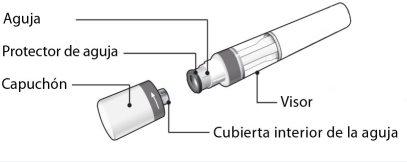
Фигура А:детали шприц-ручки Хиримоза
На Фигуре Апоказана шприц-ручка после удаления колпачка. Не удаляйте колпачок, пока не будете готовы сделать инъекцию.
Важно: |
|
Хранение шприц-ручки |
Храните Хиримоз и все лекарства в недоступном для детей месте. |
Что необходимо для инъекции? |
Поместите следующие предметы на чистую и ровную поверхность. Упаковка включает:
Упаковка шприц-ручки не включает (см. Фигуру Б):
Фигура Б:предметы, не входящие в состав упаковки |
До инъекции Подготовка шприц-ручки | |
Если шприц-ручка не проходит какие-либо из этих проверок, свяжитесь с фармацевтом. |
Фигура В:проверки безопасности перед инъекцией |
1 Выбор места инъекции: | |
Фигура Гпоказывает место инъекции.
|
Фигура Г:выберите место инъекции |
| |
|
Фигура Д:очистите место инъекции |
| |
|
Фигура Е:удалите колпачок |
| |
| |
|
Фигура Ж:держите шприц-ручку |
Инъекция |
Прежде чем сделать инъекцию, прочитайте следующее: Во время инъекции вы услышите 2 сильных щелчка:
Вы должны продолжать держать шприц-ручку плотно против кожи, пока не увидите, что зеленый индикатор занимает все смотровое окно и перестает двигаться. |
| |
|
Фигура З:начните инъекцию |
| |
|
Фигура И:закончите инъекцию |
После инъекции
| |
|
Фигура Й:проверьте зеленый индикатор |
| |
|
Фигура К:утилизация использованной шприц-ручки |
Если у вас есть вопросы, проконсультируйтесь с врачом, фармацевтом или медсестрой, знакомым с Хиримозом.
- Страна регистрации
- Активное вещество
- Требуется рецептДа
- Производитель
- Информация носит справочный характер и не является медицинской рекомендацией. Перед приемом любых препаратов проконсультируйтесь с врачом. Oladoctor не несет ответственности за медицинские решения, принятые на основе этого контента.
- Аналоги ХИРИМОЗ 40 мг РАСТВОР ДЛЯ ИНЪЕКЦИЙ В ПРЕДНАПОЛНЕННОМ ШПРИЦЕ-РУЧКЕФорма выпуска: ИНЪЕКЦИОННЫЙ РАСТВОР, 20 мгАктивное вещество: АдалимумабПроизводитель: Amgen Europe B.V.Требуется рецептФорма выпуска: ИНЪЕКЦИОННЫЙ РАСТВОР, 20 мгАктивное вещество: АдалимумабПроизводитель: Amgen Europe B.V.Требуется рецептФорма выпуска: ИНЪЕКЦИОННЫЙ РАСТВОР, 40 мгАктивное вещество: АдалимумабПроизводитель: Amgen Europe B.V.Требуется рецепт
Аналоги ХИРИМОЗ 40 мг РАСТВОР ДЛЯ ИНЪЕКЦИЙ В ПРЕДНАПОЛНЕННОМ ШПРИЦЕ-РУЧКЕ в других странах
Лучшие аналоги с тем же действующим веществом и терапевтическим эффектом.
Аналог ХИРИМОЗ 40 мг РАСТВОР ДЛЯ ИНЪЕКЦИЙ В ПРЕДНАПОЛНЕННОМ ШПРИЦЕ-РУЧКЕ в Україна
Врачи онлайн по ХИРИМОЗ 40 мг РАСТВОР ДЛЯ ИНЪЕКЦИЙ В ПРЕДНАПОЛНЕННОМ ШПРИЦЕ-РУЧКЕ
Консультация по дозировке, побочным эффектам, взаимодействиям, противопоказаниям и продлению рецепта на ХИРИМОЗ 40 мг РАСТВОР ДЛЯ ИНЪЕКЦИЙ В ПРЕДНАПОЛНЕННОМ ШПРИЦЕ-РУЧКЕ – по решению врача и с учетом местных правил.





